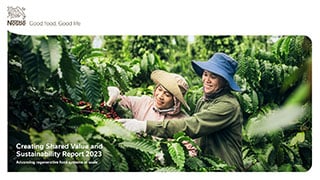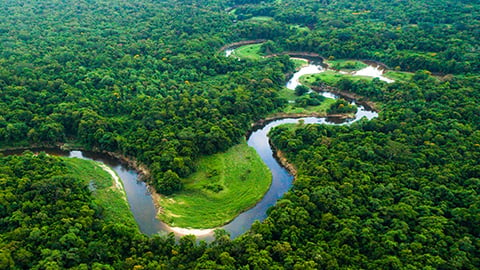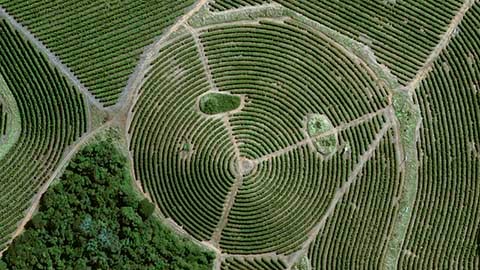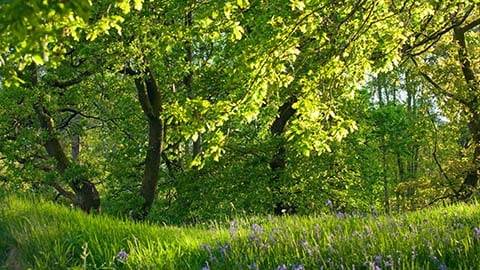Long-term forest conservation and restoration

Working toward deforestation-free supply chains is just a starting point.
We also need to take action to help keep forests standing and to help restore degraded forests and natural ecosystems, while respecting the rights of Indigenous peoples and local communities and promoting sustainable livelihoods.
Looking forward is essential. We aim to prevent deforestation and degradation, rather than responding after it has happened. To this end, we are identifying areas of future risks through a Forest Footprint methodology and engaging suppliers to take preventative action where needed.
Where forest degradation has happened, we have set an ambitious reforestation goal: through our Global Reforestation Program we aim to grow 200 million trees by 2030 in and around farms where we source our key ingredients.
Our ambition is to make conservation and restoration standard practices throughout our supply chains.
A proactive approach to reforestation
Nestlé’s plan to support forest conservation
We buy our key ingredients from farmers and suppliers. How can we encourage long-term forest conservation and restoration?
We work to:
- Obtain commitments from suppliers to identify and conserve standing forests
- Recognize and respect the land rights of Indigenous peoples and local communities
- Use satellite data to map our forest footprint and future risk areas
- Invest in forest conservation and restoration projects in and around our supply chains and sourcing landscapes
- Support sustainable livelihoods, by purchasing goods at a premium and buying greater quantities from sustainable suppliers
- Co-invest in regenerative agriculture practices like agroforestry and intercropping
- Partner with industry-wide coalitions to conserve high-value ecosystems
Proactively helping prevent deforestation
A Forest Positive future requires adopting regenerative agriculture methods working in harmony with forest conservation. Looking forward is essential to this process – anticipating where we need to focus efforts on conservation, rather than reacting to issues.
We work to identify future risks to forests, peatlands and customary land rights near our supply chains through a Forest Footprint exercise. We then engage our direct suppliers to take preventative action where needed.
Respecting land rights
Recognizing and respecting land rights is a critical step in achieving sustainable supply chains and is one of Nestlé’s 10 salient human rights issues. Indigenous peoples and local communities are central to managing forest conservation. Therefore, it is critical that our approach puts their rights front and center.
We are working to find ways to integrate further protection for tenure-based land rights into our approach. In 2023, we published our Indigenous peoples and local communities’ land rights action plan.
Supporting sustainable livelihoods
Poverty is one of the key drivers of deforestation, so supporting sustainable livelihoods is central to our efforts.
To help preserve forests, smallholder farmers and their communities need to be incentivized and empowered to improve agricultural practices and to contribute to conservation and restoration.
These farmers sometimes face specific challenges, such as low yields or aging trees, and may clear forests to grow more crops, feed their family or earn more. The world’s future challenge is to produce more food on less land, so it is critical these farmers are included in, and can benefit from, a more resilient supply chain.
Training in good agricultural practices can make a big difference in helping farmers improve yields and income. We are also co-investing in equipment, providing access to finance, helping to reduce the costs of production and helping to diversify their revenue streams.

Accelerating incomes
We have launched an income accelerator program in Côte d’Ivoire, through the Nestlé Cocoa Plan. The program aims to tackle child labor risks by incentivizing and supporting change in cocoa farming households and helping them toward a living income. It does this through a cash incentive, directly paid to the cocoa-farming family through mobile money. The program includes an incentive for undertaking agroforestry activities and planting forest and fruit trees.
Our Global Reforestation Program
We manage our reforestation activities through our Global Reforestation Program. Projects within this program include growing trees to help restore natural forest landscapes, introducing agroforestry systems for suitable crops (such as cocoa and coffee) and supporting other natural ecosystem restoration activities.
These projects aim to create co-benefits such as helping to improve soil health and water conservation, restoring degraded lands, contributing to biodiversity, mitigating climate change and supporting local livelihoods and the rights of Indigenous peoples and local communities.
To try to make sure planted trees survive and thrive, we follow a 20-year or longer project cycle for every project, which includes country- and project-level assessments and stakeholder engagement. This ensures each project and location is carefully selected, and that long-term impact monitoring is in place. For each project, verification or certification processes ensure that a robust set of carbon best practice principles (pdf, 1Mb) are implemented and respected.
We are partnering with global tree-planting experts such as One Tree Planted and PUR Projet, as well as carbon accounting partners, including NatureCO and South Pole. Together, we have set the foundations for a long-term, credible and robust program. The Nestlé Scope 3 and Sourcing Landscape Removals Framework I (pdf, 1Mb) allows us to identify which natural climate solutions to invest in and to implement in collaboration with our partners and suppliers along our value chain.
Planting trees to sequester carbon
Since 2021, we have been working with our partners to develop and implement 13 large-scale carbon removal projects across different geographical zones including Asia, Africa, Latin America and Oceania. During these projects’ lifecycle of minimum 20 years, they aim to plant and grow tens of millions of trees and sequester more than ten million tons of CO2e within Nestle’s supply chains and sourcing landscapes.
Beyond Carbon benefits, these projects also aim to improve the ecological conditions of the target supply chains and landscapes, as well as the livelihoods of the local communities residing in these areas.
Read more about our reforestation progress (pdf, 15Mb)










